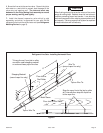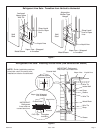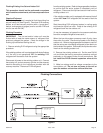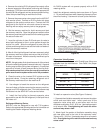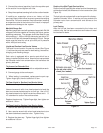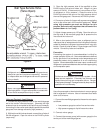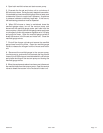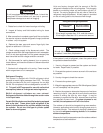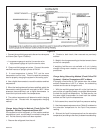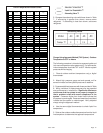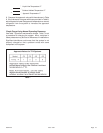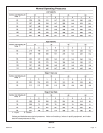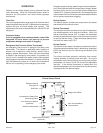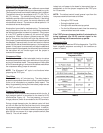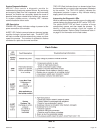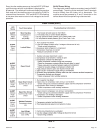
506470-01 Issue 1007
1. Connect the manifold gauge set to the service valve ports
as follows (See Figure 13 above):
• Low pressure gauge to suction line service valve
• High pressure gauge to liquid line service valve
2. Close manifold gauge set valves. Connect the center
manifold hose to an upright cylinder of R410A.
3. If room temperature is below 70°F, set the room
thermostat to call for heat. This will create the necessary
load for properly charging the system in the cooling cycle.
4. Use a digital thermometer to record the outdoor ambient
temperature.
5. When the heating demand has been satisfied, switch the
thermostat to cooling mode with a set point of 68°F. When
pressures have stabilized, use a digital thermometer to
record the liquid and suction line temperatures.
6. The outdoor temperature will determine which charging
method to use. Proceed with the appropriate charging
method.
Charge Using Weigh-In Method (Fixed Orifice/TXV
Systems) - Outdoor Temperatures Below 65°F
If the system is void of refrigerant, or if the outdoor ambient
temperature is cool, use the weigh-in method to charge the
unit. Do this after any leaks have been repaired.
1. Recover the refrigerant from the unit.
2. Conduct a leak check, then evacuate as previously
outlined.
3. Weigh in the charge according to the total amount shown
on the unit nameplate.
If weighing facilities are not available or if unit is being
charged during warm weather, use one of the following
procedures.
Charge Using Subcooling Method (Fixed Orifice/TXV
Systems) - Outdoor Temperatures 65°F or Above
If charging a fixed orifice or TXV system when the outdoor
ambient temperature is 65°F or above, the subcooling
method can be used to charge the unit.
1. With the manifold gauge hose still on the liquid service
port and the unit operating stably, use a digital thermometer
to check the liquid line temperature. For best results, use
the same digital thermometer to check both the outdoor
ambient and the liquid line temperatures.
2. At the same time, record the liquid line pressure reading.
3. Use the temperature/pressure chart (Table 5) to determine
the saturation temperature for the liquid line pressure
reading.
4. Subtract the liquid line temperature from the saturation
temperature (according to the chart) to determine subcooling.
Page 14
Figure 13



